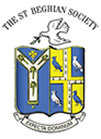|
 |
The Old St Beghian | |
| July 2021 | |||
Andrew Johnston (G 68-73) has kindly supplied the eulogy, of which this is an edited version, which was read at the funeral of his father, David Johnston (FN 41-44),
who died in April.
“Dad was educated at St Bees School with his brother Arthur. He obviously enjoyed school and had fond memories of his time there. He was a member of the first fifteen for two years and was awarded a rugby cap as well as winning the school golf cup. He later became a governor of the school, from 1970 until 2004.
He told me he volunteered for the Royal Marines but his father stopped this and, noting his artistic flair and interest in buildings and that he was a practical boy, decided he should leave St Bees early, aged seventeen. He subsequently obtained a place at the Architectural Association in London in 1944. Here he began his architectural education, but this was interrupted by his joining the army – the Royal Engineers – in 1945. Dad never really talked about his experience in the army, but occasionally mentioned that he was stationed in Munster, Germany, near Saten, which is close to the infamous Belsen concentration camp. He was involved in the repatriation of displaced persons from the concentration camps in East Germany and this had a very profound effect on him.
In 1948, after national service, he returned to complete his architectural education in London together with his practical training where, in 1951, he met my mother Jane, who was then studying at the central school of speech and drama.
In 1953 he returned to Carlisle to join his brother Arthur in the family architectural practice, Johnston and Wright, which became very successful under their leadership and achieved some fifty architectural awards and commendations. Although dad was involved in all aspects of architecture, his main interest and speciality was in the field of social housing, and in 1980 he received an OBE for his services to architecture.
In 1976 after many years of wild ideas about purchasing run down farms in odd locations, selling the land and adapting the buildings, he designed his own house at Longburgh Head. He would often disparagingly describe the house as two council houses banged together, but he was able to build a workshop, which allowed him to enjoy one of his main hobbies: working with wood. He enjoyed making benches, tables, restoring and fixing furniture, new barn doors for my dilapidated farm buildings and tuck boxes for Alice, Lucy and Robert when they went to St Bees, amongst other objects.
Of his many interests painting was one that fell away. He exhibited regularly at the local art exhibition in Tullie house for a number of years. I do remember him being very upset when one year his paintings were returned without being exhibited. Although some people requested paintings by him, he never enjoyed painting to commission.
In 1963 he bought Rosebank, a dilapidated cottage which he restored as a basic holiday cottage, a forerunner of today’s Glamping – he always described the cottage as camping with a roof, hot water and large wood fire. This became the annual holiday-home as a family for many years. Tennis occupied each evening by walking across fields and crossing the burn to play on the local sloping grass courts with an uneven bounce! The cottage is unchanged and still in use, and it may come into its own again this year.
Sport and competing were important to him. Although always competitive, taking part was more important and winning not essential. He created a tennis court in the garden at Longburgh; this also was sloping but that didn’t matter, it was part of the game along with local rules: change ends every odd game and have another glass of wine or gin and tonic. It was taking part that mattered.
Golf was another interest which he took up again seriously later in life after teaching me to play. He was a member of Silloth, Southerness and the R and A. Golf clubs. Negotiating strokes was always important and I remember as a small boy playing with dad in ‘father and son’ matches with Jack and David Hodgson (both OSBs) and later with the Dinwiddie’s. The Dinwiddie matches had additional interest and honour as it was also St Bees versus Sedbergh. Stroke negotiation would still be going on at the fifth, if not the ninth.
Fishing became another hobby and major interest. His main enjoyment was fishing for trout and sea trout, particularly on the lochs in South Uist.
Dad was also a member of Burgh PCC for a number of years; he was the fabric officer and took a lot of interest in the church and graveyard. He was also a member of the Burgh Marsh committee for some 35 years and chair for fifteen years.
Another interest in his life was his love of music. He loved singing hymns and carols, also singing along to his recordings of choral works. He would have considered it better not to have hymns at all at a service if they couldn’t be sung.”
Home
The St Beghian Society
St Bees School,
St Bees, Cumbria, CA27 0DS.
Tel: (01946) 828093 Email: osb@stbeesschool.co.uk
Web: www.st-beghian-society.co.uk
![]()